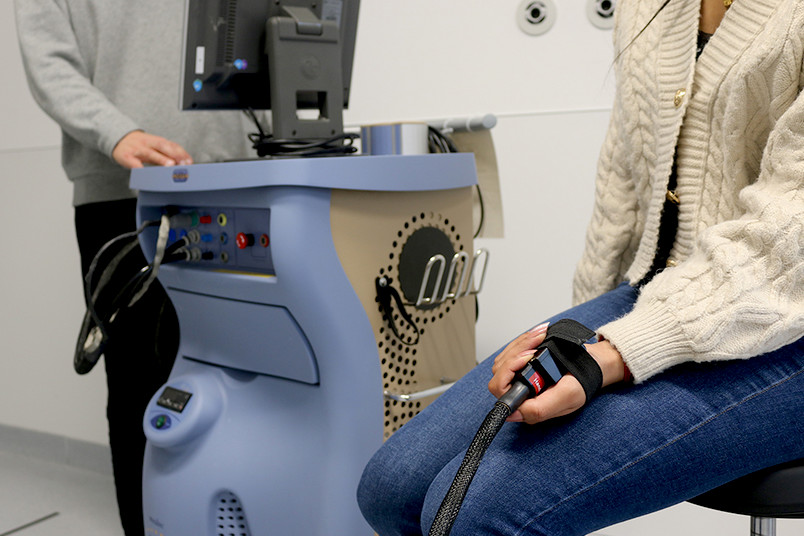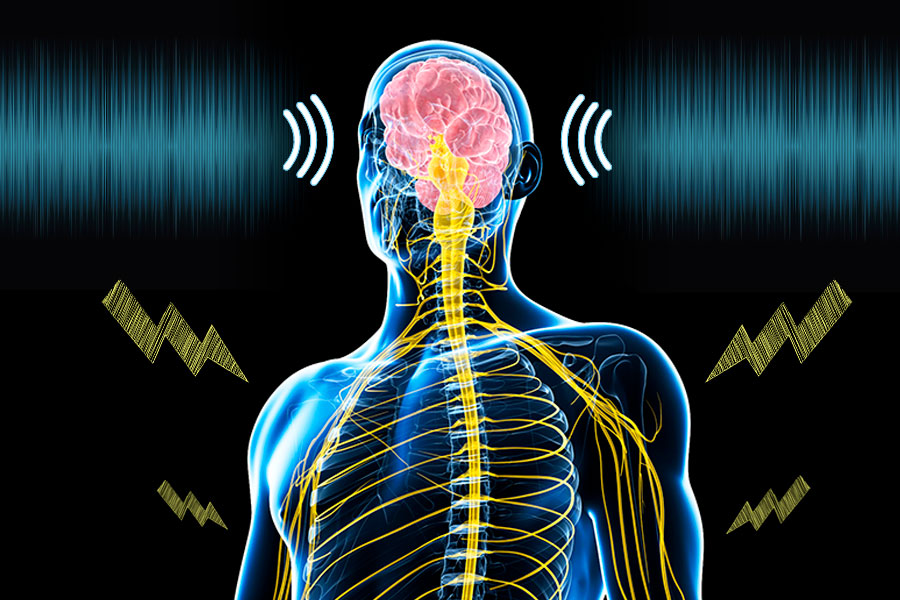Research published in Science Advances traced the history of human’s ability to feel cold back to the molecular underpinnings of the cold and menthol sensor TRPM8 over hundreds of millions of years. The findings could lead to non-addictive pain medications, a crucial development given the opioid crisis.
Tag: Chronic Pain
Confronting trauma alleviates chronic pain among older veterans
A new study led by UCLA Health and the U.S. Veterans Affairs Office found chronic pain among older adults could be significantly reduced through a newly developed psychotherapy that works by confronting past trauma and stress-related emotions that can exacerbate pain symptoms.
Study links chronic pain to quality of family relationships
Strong family relationships have long been associated with a better sense of well-being and connection. Now a team led by UT Southwestern Medical Center researchers has linked the quality of those relationships with how successfully people – particularly aging African Americans – manage pain.
Mindfulness Meditation: A Promising Remedy for Addiction and Chronic Pain
A particular form of mindfulness emphasizing pleasure works as well as a starting dose of a narcotic for pain and better than traditional psychotherapy for substance abuse.
AANA Issues Updated Practice Considerations for Ketamine Therapy for Psychiatric Disorders and Chronic Pain Management
The American Association of Nurse Anesthesiology (AANA) recently updated its practice considerations addressing ketamine therapy to cite the most current studies, as AANA continues to support a patient-centered, interdisciplinary approach to providing care and treatment to persons with psychiatric disorders or chronic pain.
Medical Cannabis Certification Patterns for Chronic Pain
In light of the national opioid crisis, a recent study by researchers at the Rothman Orthopaedic Institute and its Department of Medical Cannabis explores the use of medical cannabis (MC) as a potential alternative for chronic pain management.
Empowering autistic teens: New clinician advice for navigating chronic pain
When you’re an autistic teenager living with chronic pain, getting treatment for your pain can be a challenging experience.
Long COVID-19 is linked to chronic pain conditions
Therapies for pain conditions like fibromyalgia provide clues for helping those with long COVID, finds a new University of Michigan study.
NIH Awards Wake Forest University School of Medicine $10 Million to Study Long-term Opioid Use, Chronic Pain
Researchers at Wake Forest University School of Medicine have received a five-year $10 million grant from the National Institute on Drug Abuse, part of the National Institutes of Health (NIH), to create a broad research program that will work to reduce opioid-related harms and improve quality of life in patients on long-term opioid therapy.
Long COVID patients show distinct immune, hormone responses to virus
People suffering from long COVID symptoms show different immune and hormonal responses to the virus that causes COVID-19, according to a new study led by researchers at Yale School of Medicine. An estimated 7.5% of people infected with the SARS-CoV-2…
Hulk Smash! New VR ‘Superhero Therapy’ crushes chronic pain
We’ve all heard of the Incredible Hulk, the green-skinned, muscular superhero with limitless strength. So, imagine what you could do if you could assume his persona and power?
Symptoms of the body and the mind are frequent fellow travelers
Chronic pain is often accompanied by depression and anxiety. An invited commentary discusses the relationship between pain, the most common symptom for which individuals visit a physician, and depression and anxiety, the two most prevalent mental health conditions worldwide. It highlights the importance of not neglecting psychological symptoms in patients experiencing pain.

When Blood Is a New Alternative Medicine for Pain Relief at Chula Pain Clinic
Chula Medicine researchers have successfully published an article on the injection of patient’s own platelets rich plasma into the shoulder ligaments resulting in pain reduction, heal torn ligaments and restore torn muscles as an alternative to surgery while reducing the side effects of prolonged use of pain medications.
People Generalize Expectations of Pain to Conceptually Related Tasks
Avoiding experiences associated with pain can be an adaptive behavior. But when avoidance generalizes to safe movements and activities, it can come at the cost of other valued activities or even culminate in disability due to reduced activity levels.
MD Anderson Research Highlights for May 24, 2023
The University of Texas MD Anderson Cancer Center’s Research Highlights showcases the latest breakthroughs in cancer care, research and prevention.
A Leader Fighting the Overdose Crisis Urges Standardizing Addiction Medicine Education and Supporting New DEA Requirements
According to the Centers for Disease Control and Prevention (CDC) and The National Vital Statistics System, drug-related overdose deaths have been rising over the past two decades in the United States. In 2021, 106,699 drug overdose deaths occurred. Adults aged 65 and over…

Pain out of control
A study conducted by the team at the Clinic for Psychosomatic Medicine and Psychotherapy at Ruhr University Bochum, Germany, provides evidence that certain brain areas involved in processing pain don’t function normally in fibromyalgia patients. In healthy people, they ensure that pain that we can control is easier to bear.
Debunking pain myths could help teens recover faster
Whether it’s headaches, abdominal pain, or unrelenting joint soreness, up to a third of young people in Australia experience chronic pain. Now, a world-first study from the University of South Australia is providing valuable insights about how young people understand chronic pain, potentially helping thousands of sufferers to better manage their symptoms and long-term wellbeing.
Researchers identify gene mutation capable of regulating pain
Pain afflicts at least 1.5 billion people worldwide, and despite the availability of various painkilling drugs, not all forms of pain are treatable.
Summary of VA/DoD guidelines for management of chronic pain provides new recommendations on opioid use and mental health evaluations
In May 2022, leadership within the U.S. Department of Veterans Affairs (VA) and U.S. Department of Defense (DoD) approved a joint clinical practice guideline for the use of opioids when managing chronic pain.
Study Unravels Interplay Between Sleep, Chronic Pain and Spinal Cord Stimulation
Spinal cord stimulation uses low levels of electricity to relieve pain. A study is the first to measure this treatment’s effects on patients by gauging improvement in insomnia after spinal cord stimulation. Results showed a 30 percent or more improvement of both nighttime and daytime components of insomnia in 39.1 percent of study participants and a 30 percent or more improvement of daytime sleepiness in 28.1 percent of participants. Findings correlated with improvement in disability and depression and revealed associations with sleep and both pain and depression. Results will help clinicians gain a better understanding of the type of patient most likely to benefit from this treatment.
Nearly 1/3 of people with chronic pain turn to cannabis
According to a new study published in JAMA Network Open, almost a third of patients with chronic pain reported using cannabis to manage it.
Ultrasound Device for Pain Gets ‘Nod’ from Shark Tank and NIH Funding
A project using focused ultrasound is one of seven selected by the NIH, which also has received successful reviews from ABC’s “Shark Tank.” Researchers are developing a handheld probe to provide a noninvasive, non-opioid-based treatment for aggravated chronic pain for use in a physician’s office or potentially even at home. The device directs low-intensity ultrasound at the dorsal root ganglia – small bundles of nerves along the spine that control pain signals reaching the spinal cord – to provide means for precise treatment of back and leg pain.
A handy lesson about pain and the brain in stroke survivors
A world-first study of stroke survivors shows how chronic pain can alter body perception, with the brain tricking patients into believing their affected hand is a different size, increasing the risk of accidents.
Wrist-Worn Device Potentially Offers Objective Measure of the Impact of Chronic Pain on Function
Effectively treating chronic pain is challenging because pain experiences are highly subjective. To select the best treatments, physicians rely on patient perceptions, costly tests, and lengthy examinations.
Chronic pain associated with poor health – and COVID-19 infection – decades later
Data on more than 12,000 Britons also shows links with subsequent poor mental health, worse sleep, joblessness.
Dr. Jose De Andres to Present the 2022 John J. Bonica Lecture at the 21st Annual Pain Medicine Meeting
ASRA Pain Medicine has selected Jose De Andres, MD, PhD, FIPP, EDRA, EDPM, to receive the 2022 John J. Bonica Award. The honor recognizes an individual who has demonstrated outstanding contributions to the development, teaching, and practice of pain medicine in the tradition of John J. Bonica, MD, the pioneering anesthesiologist regarded as the founding father of pain relief medicine.
Drinking to Manage Physical Pain Results in Perceived Relief, Increasing Vulnerability to Dangerous Alcohol Use
People who self-medicate pain with alcohol may be vulnerable to hazardous drinking, with their experience of pain relief a potentially powerful driver of alcohol consumption, a new study suggests. Both pain and dangerous alcohol use are major public health issues. Each affects millions of US adults and costs hundreds of billions of dollars annually in health care and lost productivity. Recent studies have demonstrated a strong correlation between pain and alcohol use; people with chronic pain are more likely than others to report heavy drinking, and those with alcohol use disorder (AUD) are more likely to report chronic pain. Alcohol has known analgesic effects. Evidence of shared neural mechanisms underlying chronic pain and substance misuse suggest alcohol’s pain-relieving capacity might be influenced by individuals’ experience of chronic pain. Better understanding the relationship between chronic pain and alcohol use could inform improved prevention and treatment approaches. For the

Study finds that sound plus electrical body stimulation has potential to treat chronic pain
A University of Minnesota Twin Cities-led team has found that electrical stimulation of the body combined with sound activates the brain’s somatosensory cortex, increasing the potential for using the technique to treat chronic pain and other sensory disorders.
Online Chair Yoga Viable Exercise for Isolated Older Adults with Dementia
Researchers evaluated a remotely supervised online chair yoga intervention targeted at older adults with dementia and measured clinical outcomes virtually via Zoom under the remote guidance. Results showed that remotely supervised online chair yoga is a feasible approach for managing physical and psychological symptoms in socially isolated older adults with dementia based on retention (70 percent) and adherence (87.5 percent), with no injury or other adverse events.
Scientists develop blueprint for turning stem cells into sensory interneurons
Key takeaways:
• Just like the real thing. The stem cell–derived interneurons, which play a role in sensations like touch and pain, are indistinguishable from their real-life counterparts in the body.
• Tomorrow’s therapies. In addition to potential treatments for injury-related sensation loss, the discovery could lead to new methods for screening drugs for chronic pain.
• Moving forward. While stem cells from mice were used in the research, scientists are now working to replicate the findings with human cells.
Mindfulness Meditation Reduces Pain by Separating it from the Self
Mindfulness meditation is effective in reducing pain relief; UC San Diego study reveals the underlying neural circuitry.
Researchers discover how sound reduces pain in mice
An international team of scientists has identified the neural mechanisms through which sound blunts pain in mice. The findings, which could inform development of safer methods to treat pain, were published in Science.
UCalgary Researchers Discover Molecule in the Nervous System That May Hold Key to Treating Chronic Pain
A newly published study by University of Calgary researchers reveals a potential new way to treat chronic pain using anti-cancer drugs rather than opioid-based pain medication.
How does the brain process heat as pain?
A team of researchers at the Case Western Reserve University School of Medicine believe they’ve found an answer to how thermal pain is sensed.
Discovery in the brains of army veterans with chronic pain could pave way for personalized treatments
A new study is the first to investigate brain connectivity patterns at rest in veterans with both chronic pain and trauma, finding three unique brain subtypes potentially indicating high, medium, and low susceptibility to pain and trauma symptoms.
High-Frequency Spinal Cord Stimulation Shows Improved Longer Lasting Pain Relief
Researchers at UC San Diego School of Medicine report that high-frequency spinal cord stimulation proved more effective at improving perceived pain reduction than low-frequency SCS in patients studied, and that there was some variation in PPR between male and female patients.

AI Could Predict Ideal Chronic Pain Patients for Spinal Cord Stimulation
Spinal cord stimulation is a minimally invasive FDA-approved treatment to manage chronic pain such as back and neck pain. The ability to accurately predict which patients will benefit from this treatment in the long term is unclear and currently relies on the subjective experience of the implanting physician. A study is the first to use machine-learning algorithms in the neuromodulation field to predict long-term patient response to spinal cord stimulation.
Protocol Based on Questionnaires and a Mental Health Checklist Can Replace In-Person Psychological Assessment Before Neuromodulation Therapies
Researchers at Toronto Western Hospital in Canada have proposed a protocol for patients undergoing neuromodulation implantation that incorporates a short mental health checklist and pre-defined cut-offs on validated questionnaires to assess the need for an in-person assessment by a psychologist.
Steroid Use Significantly Reduces Pain After Radiofrequency Neurotomy
Radiofrequency neurotomy is used to provide long-term relief for chronic neck and lower-back pain. The most common side effect is a sensation of burning, numbness, and shooting in the area where the needles were placed. This study found that steroids significantly reduce this side effect.
Novel Drug Delivery Matrix Significantly Extends Pain Relief After Surgery
A novel drug delivery matrix currently in pre-clinical development may offer a narcotic-free alternative for patients experiencing pain after surgery.
Wrist Innervation Anatomy Provides a Roadmap for Chronic Pain Management
More than 11 million Americans experience chronic wrist pain. Percutaneous denervation, a procedure that interrupts the signal from the nerve to the brain, is emerging as a non-invasive alternative for chronic wrist pain. A recent study explored specific sites in the wrist enable effective use of this technique.
Disparities Exist in Kyphoplasty Treatment for Black and Lower-Income Medicare Recipients
A new study found that kyphoplasty was less likely to be performed in Black patients, as well as in patients with dual Medicare and Medicaid eligibility, who tend to be lower-income older adults.
Veterans with Traumatic Brain Injury: M.O.M. to the Rescue
The M.O.M. project, which will have four units in Ohio, Florida, South Carolina and Texas, will engage veterans with traumatic brain injury, their caregivers and other stakeholders to bolster patient-centered outcomes research and comparative effectiveness research in order to identify treatment options for traumatic brain injury that are effective, acceptable, and meaningful to the veteran population.
Not So Great Expectations: Pain in HIV Related to Brain’s Expectations of Relief
Neuroimaging study reveals potential brain mechanism underlying chronic neuropathic pain in individuals with HIV. Findings may guide new clinical treatments targeting patients’ expectations for pain relief.
Exploring the Science of Acupuncture
Researchers have discovered neurons needed for acupuncture‘s anti-inflammatory response
NIH Awards Grant to Study Combination Treatment for Pain to Wake Forest School of Medicine
Chronic musculoskeletal pain (CMP) – daily pain in the muscles, bones, ligaments, tendons and nerves that lasts for six months or longer – contributes to approximately 21% of worker disability issues in this country and costs $500 billion annually from lost wages, treatment and medications, according to a study conducted by Johns Hopkins University.
In an effort to develop a more effective strategy against this debilitating condition, a team of doctors and researchers at Wake Forest School of Medicine has received a four-year grant of approximately $4 million from the National Institutes of Health.
Dr. Oscar de Leon-Casasola Named 2021 John J. Bonica Awardee, Will Present Lecture at ASRA’s 20th Annual Pain Medicine Meeting
Oscar de Leon-Casasola, MD, has been selected to receive the 2021 John J. Bonica Award. The honor recognizes an individual who has demonstrated outstanding contributions to the development, teaching and practice of pain medicine in the tradition of John J. Bonica, MD, the pioneering anesthesiologist regarded as the “founding father of pain relief medicine.”
Dr. Kevin Vorenkamp From Duke University Named 2021 ASRA Presidential Scholar
The American Society of Regional Anesthesia and Pain Medicine Presidential Scholar Award recognizes outstanding scientific and sustained contributions to regional anesthesia and acute or chronic pain medicine over the preceding 10 years.
Weather can affect pain tolerance, reports study in PAIN®
Can the weather affect pain from conditions like arthritis or migraine? It may sound like an old superstition – but on some standard quantitative sensory tests, weather-related factors do indeed affect pain tolerance, suggests a study in PAIN®, the official publication of the International Association for the Study of Pain (IASP). The journal is published in the Lippincott portfolio by Wolters Kluwer.